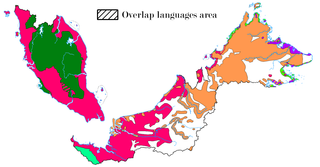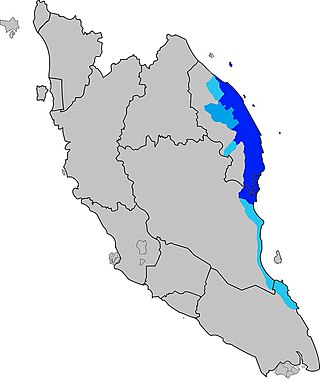Related Research Articles

The demographics of Malaysia are represented by the multiple ethnic groups that exist in the country. The official estimate of 2024 Malaysia's population is about 34,100,000 people. According to the 2020 census, is 32,447,385 including non-citizens, which makes it the 43rd most populated country in the world. Of these, 5.72 million live in East Malaysia and 22.5 million live in Peninsular Malaysia. The population distribution is uneven, with some 79% of its citizens concentrated in Peninsular Malaysia, which has an area of 131,598 square kilometres (50,810.27 sq mi), constituting under 40% of the total area of Malaysia.

Malay is an Austronesian language that is an official language of Brunei, Malaysia, and Singapore. Indonesian, a standardized Malay-based national variety, is the official language of Indonesia and is one of working languages in East Timor. Malay is also spoken as a regional language of ethnic Malays in Indonesia and the southern part of Thailand. Altogether, it is spoken by 290 million people across Maritime Southeast Asia.

The Peranakan Chinese are an ethnic group defined by their genealogical descent from the first waves of Southern Chinese settlers to maritime Southeast Asia, known as Nanyang, namely the British, Portuguese, and Dutch colonial ports in the Malay Peninsula and the Indonesian Archipelago, as well as Singapore. The Peranakan Chinese are often simply referred to as the Peranakans. Peranakan culture, especially in the dominant Peranakan centres of Malacca, Singapore, Penang, Phuket, and Tangerang, is characterized by its unique hybridization of ancient Chinese culture with the local cultures of the Nusantara region, the result of a centuries-long history of transculturation and interracial marriage.

Portuguese creoles are creole languages which have Portuguese as their substantial lexifier. The most widely-spoken creoles influenced by Portuguese are Cape Verdean Creole, Guinea-Bissau Creole and Papiamento.
Papia Kristang or Kristang is a creole language spoken by the Kristang, a community of people of mixed Portuguese and indigenous Malay ancestry, chiefly in Malaysia (Malacca), Singapore and Perth, Australia.

In addition to its classical and modern literary form, Malay had various regional dialects established after the rise of the Srivijaya empire in Sumatra, Indonesia. Also, Malay spread through interethnic contact and trade across the south East Asia Archipelago as far as the Philippines. That contact resulted in a lingua franca that was called Bazaar Malay or low Malay and in Malay Melayu Pasar. It is generally believed that Bazaar Malay was a pidgin, influenced by contact among Malay, Hokkien, Portuguese, and Dutch traders.
The Chitty, also known as the Chetty or Chetti Melaka, are an ethnic group whose members are of primarily Tamil descent, found mainly and initially in Melaka, Malaysia, where they settled around the 16th century, and in Singapore where they migrated to in the 18th and 19th centuries from Melaka. Also known colloquially as "Indian Peranakans", the culture of the Chitty has drawn significant influence from the Nusantara region and to a small extent the Chinese, whilst also retaining their Hindu faith and heritage. In the 21st century, their population stands at 2,000. The Chitty/Chetti community are different from Chettiar, bankers brought from Tamil Nadu to British Malaya. They are practising Hindus.

Southern Thai, also known as Dambro, Pak Tai, or "Southern language", is a Southwestern Tai ethnolinguistic identity and language spoken in southern Thailand, as well as by small communities in the northernmost states of Malaysia. It is spoken by roughly five million people and as a second language by the 1.5 million speakers of Pattani and other ethnic groups such as the local Peranakan communities, Negritos and other tribal groups. Most speakers are also fluent in or understand the Central Thai dialects.

Malacca City is the capital city of the Malaysian state of Malacca, in Melaka Tengah District. It is the oldest Malaysian city on the Straits of Malacca, having become a successful entrepôt in the era of the Malacca Sultanate. The present-day city was founded by Parameswara, a Sumatran prince who escaped to the Malay Peninsula when Srivijaya fell to the Majapahit. Following the establishment of the Malacca Sultanate, the city drew the attention of traders from the Middle East, South Asia, and East Asia, as well as the Portuguese, who intended to dominate the trade route in Asia. After Malacca was conquered by Portugal, the city became an area of conflict when the sultanates of Aceh and Johor attempted to take control from the Portuguese.
Temuan language is a Malayic language spoken by the Temuan people, one of the Orang Asli or indigenous peoples of Peninsular Malaysia which can be found in the states of Selangor, Pahang, Johor, Malacca and Negeri Sembilan. Temuan is a separate language but has a degree of mutual intelligibility with the Malay language. It is written in a Latin alphabet, but no standard orthography has been made.
Sri Lankan Malay, also known as Sri Lankan Creole Malay, bahasa Melayu, Ja basawa, or Java mozhi, is a Malay-based creole language spoken in Sri Lanka, formed as a mixture of Sinhala and Shonam, with Malay being the major lexifier. It is traditionally spoken by the Sri Lankan Malays, Javanese Sri Lankans, and among some Sinhalese in Hambantota. Today, the number of speakers of the language have dwindled considerably but it has continued to be spoken notably in the Hambantota District of Southern Sri Lanka, which has traditionally been home to many Sri Lankan Malays.

The indigenous languages of Malaysia belong to the Mon-Khmer and Malayo-Polynesian families. The national, or official, language is Malay which is the mother tongue of the majority Malay ethnic group. The main ethnic groups within Malaysia are the Malays, Malaysian Chinese and Tamils, with many other ethnic groups represented in smaller numbers, each with its own languages. The largest native languages spoken in East Malaysia are the Iban, Dusunic, and Kadazan languages. English is widely understood and spoken within the urban areas of the country; the English language is a compulsory subject in primary and secondary education. It is also the main medium of instruction within most private colleges and private universities. English may take precedence over Malay in certain official contexts as provided for by the National Language Act, especially in the states of Sabah and Sarawak, where it may be the official working language. Furthermore, the law of Malaysia is commonly taught and read in English, as the unwritten laws of Malaysia continue to be partially derived from pre-1957 English common law, which is a legacy of past British colonisation of the constituents forming Malaysia. In addition, authoritative versions of constitutional law and statutory law are continuously available in both Malay and English.

Kedah Malay or Kedahan or as it is known in Thailand, Syburi Malay is a Malayic language mainly spoken in the northwestern Malaysian states of Perlis, Kedah, Penang, and northern Perak and in the southern Thai provinces of Trang and Satun. The usage of Kedah Malay was historically prevalent in southwestern Thailand before being superseded by the Thai language. Enclaves of Kedah Malay can be found in Kawthaung District in Myanmar; Ranong and Krabi in upper southern Thailand; Jaring Halus, Langkat and Aceh in Sumatra, Indonesia and up north in Bangkok, central Thailand, where most of the Kedah Malay speakers are descendants of historical settlers from Kedah.

Malay Indonesians are ethnic Malays living throughout Indonesia. They are one of the indigenous peoples of the country. Indonesian, the national language of Indonesia, is a standardized form of Riau Malay. There were numerous kingdoms associated with the Indonesian Malays along with other ethnicities in what is now Indonesia, mainly on the islands of Borneo and Sumatra. These included Srivijaya, the Melayu Kingdom, Dharmasraya, the Sultanate of Deli, the Sultanate of Siak Sri Indrapura, the Riau-Lingga Sultanate, the Sultanate of Bulungan, Pontianak Sultanate, and the Sultanate of Sambas. The 2010 census states that there are 8 million Malays in Indonesia; this number comes from the classification of Malays in East Sumatra and the coast of Kalimantan which is recognized by the Indonesian government. This classification is different from the Malaysia and Singapore census which includes all ethnic Muslims from the Indonesian archipelago as Malays.

Kedahan Malays or commonly known as Orang Utara ('Northerners'), are a sub-group of Malays native to northern Malay Peninsula in areas of both current and historical area of Kedah. They are among the oldest ethnic groups in the Malay peninsula with a history dating back 2,800 years as proven by the discovery of sites in Bujang Valley and historical documents from India, China and Arabia. Kedahan Malays are one of the largest Malay sub-groups in Malaysia, comprising at least 15% of the total Malaysian Malay population including those with Kedahan ancestry.

Terengganu Malay is a Malayic language spoken in the Malaysian state of Terengganu all the way southward to coastal Pahang and northeast Johor. It is the native language of Terengganu Malays and highly localized Chinese Peranakan community as well as a second language among the smaller Indian minority.
Cocos Malay is a post-creolized variety of Malay, spoken by the Cocos Malays of Home Island, Christmas Island, and those originally from the Cocos Islands currently living in Sabah.

Malacca, officially the Historic State of Malacca, is a state in Malaysia located in the southern region of the Malay Peninsula, facing the Strait of Malacca. The state is bordered by Negeri Sembilan to the north and west and Johor to the south. The exclave of Tanjung Tuan also borders Negeri Sembilan to the north. Its capital is Malacca City, which has been listed as a UNESCO World Heritage Site since 7 July 2008.
Malay spoken by a minority of Filipinos, particularly in the Palawan, Sulu Archipelago and parts of Mindanao, mostly in the form of trade and creole languages, such as Sabah Malay.

Penangite Indians, also known as Chulias, are Malaysian Indians that live primarily in the state of Penang, Malaysia. Most are the descendants from those who migrated from India during the British colonisation of Malaya. However, historical sources prove that the ancient Indians arrived in Penang during the Chola dynasty. Penangite Indians forms a large percentage of the state's professional community such as business, law and medicine as well as politics, it can be proven by the appointment of Dr. P. Ramasamy as deputy chief minister of Penang. It made him the first Malaysian of Indian origin to hold the post of deputy chief minister in any state of Malaysia. In addition, first Tamil Vernacular School in Malaysia was established in Penang.
References
Citations
- ↑ Malay Chetty creole language at Ethnologue (25th ed., 2022)

- 1 2 "Malaccan Malay Creole". Ethnologue. Retrieved 2021-04-29.
- ↑ Paulo 2018.
- ↑ Mohamed 2009, pp. 58–59.
- ↑ Mohamed 2009, p. 68.
- ↑ Mohamed 2009, pp. 60–65.
- ↑ Mohamed 2009, pp. 67–68.
Bibliography
- Paulo, Derrick A (21 October 2018). "Meet the Chetti Melaka, or Peranakan Indians, striving to save their vanishing culture". CNA . Retrieved 28 April 2021.
- Mohamed, Noriah (June 2009). "The Malay Chetty Creole Language of Malacca: A Historical and Linguistic Perspective". Journal of the Malaysian Branch of the Royal Asiatic Society . 82 (1 (296)): 58–59. JSTOR 41493734 . Retrieved 23 May 2021.